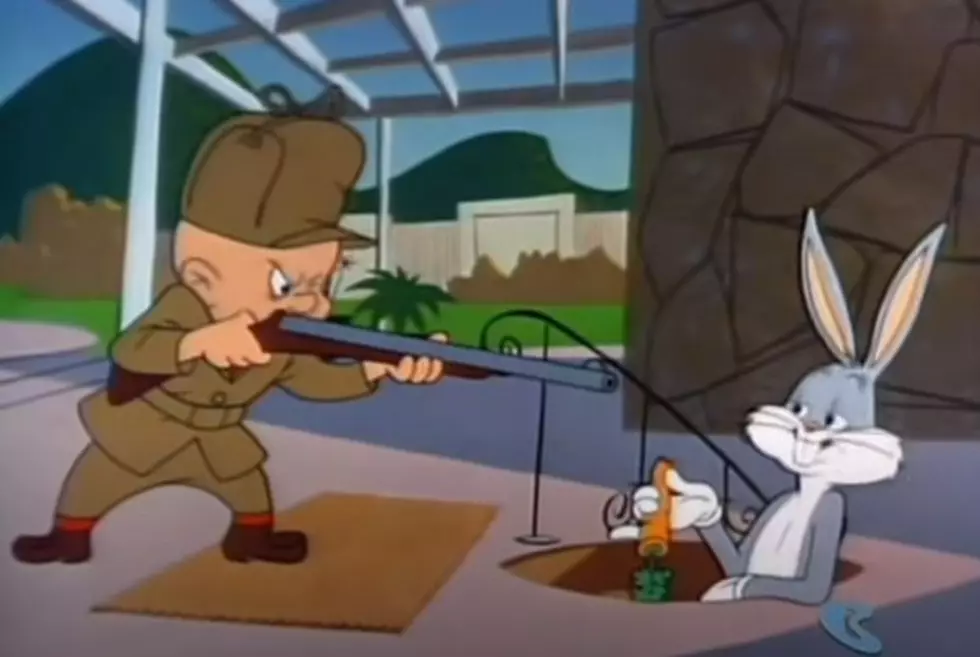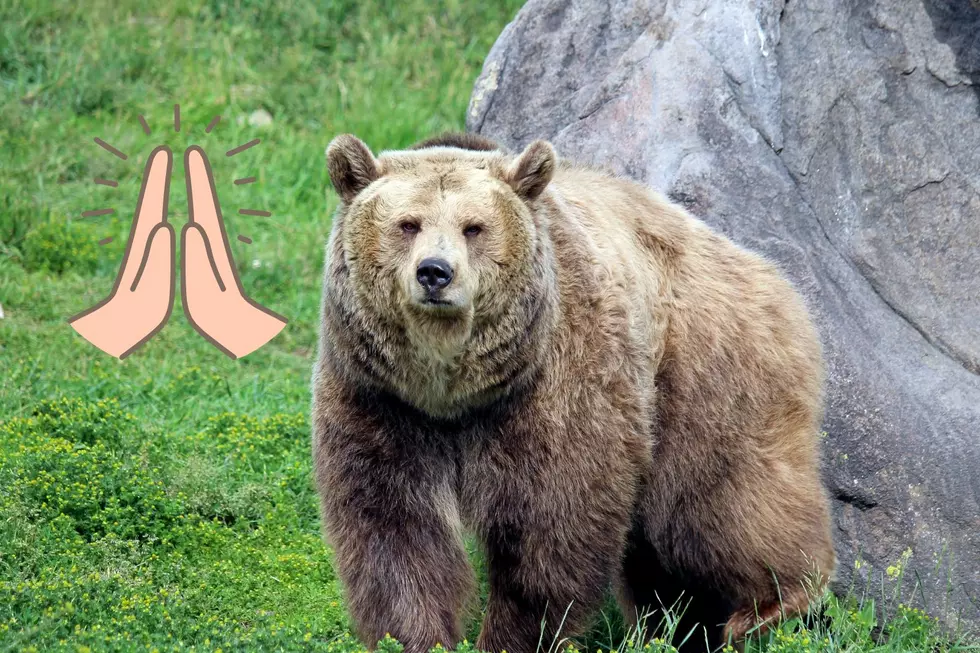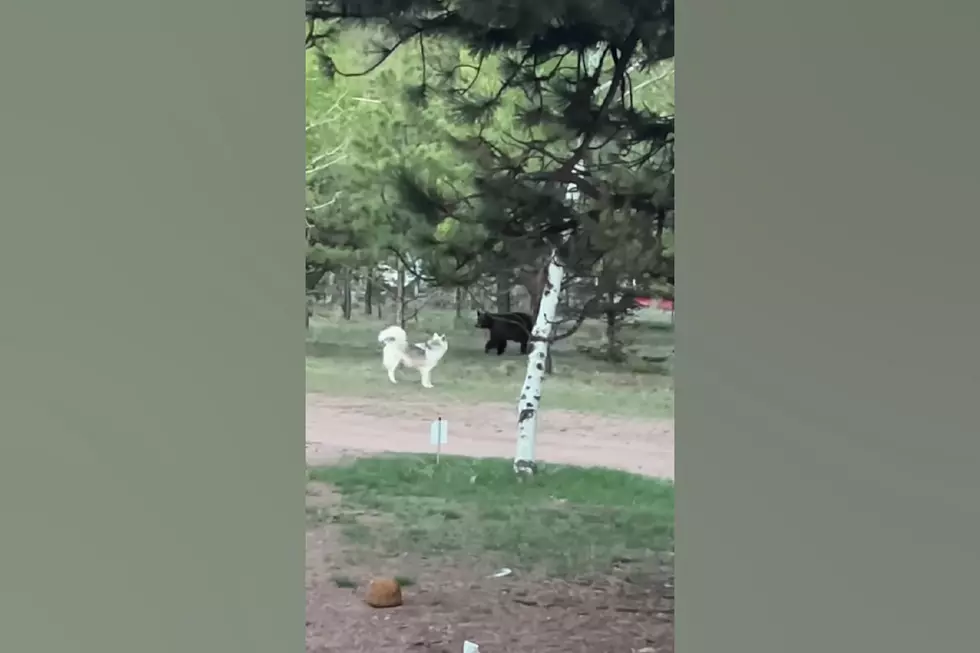
Bear Conflicts Down in Jackson Hole Area of NW Wyoming
JACKSON, Wyo. (AP) — Margaret Gordon learned a bear was on the loose about 20 minutes after her youngest daughter had ridden her bike to the bus stop.
"I ended up calling the school to make sure she got there" on Oct. 8, Gordon said. "It was a little alarming."
Her older daughter later said she saw the bear cruise through their backyard and make its way down the street.
"She said it was so busy eating that when she pulled her bike out of the garage, it didn't even look in her direction," Gordon said. "She just hopped on her bike and rode the other way, quickly. We told her after she told us that story, 'Feel free to stay in the house and call us. A bear is a perfectly fine excuse to be late to school.'"
Despite a recent rash of bears spotted near civilization, the Wyoming Game and Fish Department said this year is a below-average one for human-bear conflicts.
"Really, this summer we had a pretty slow year as far as bear conflicts go here in the valley," spokesman Mark Gocke said.
A cluster of recent headlines doesn't tell the whole story. In an average year Game and Fish responds to between 60 and 80 bear conflicts. This year is a bit lower, with between 50 and 60 reported so far. A few weeks remain before bears retreat to their dens for the winter.
In dry years lacking an abundant berry crop, reports of bear conflicts tend to increase. Mike Boyce, a large carnivore biologist, remembered 2012 as a particularly bad one. He responded to 200 conflicts that year.
News that a Grand Teton National Park sow black bear was killed Oct. 9 after humans fed it fruit, resulting in her cubs being sent to a Michigan zoo, and that a boar black bear was killed Oct. 12 after frequenting neighborhoods near several Teton County schools prompted outrage and questions.
"I'm very disappointed in the actions of wildlife personnel this past week," William Kunkle, a Wilson resident, wrote in an email. "Two black bears have been killed and two cubs have both lost their mother and their freedom. All of the bears should have been relocated. I don't want to hear, 'It's a tough decision.' Do your job, which is to protect both humans and wildlife. The easy decision is killing the bears. The hard work is removing them."
Others were slightly more supportive, especially in the case of the bear that was lurking close to five schools and even more bus stops.
"It is sad, and I recognize why so many people would be upset," said Andrea Weenig, a mother of three in the Ellingwood neighborhood.
She saw the bear Monday morning and called it in, then trailed it in her car and honking at it occasionally until it moved west, away from homes.
"It kind of seems like even without the (grizzly) bear hunt, there's been a lot of bears dying recently due to conflict with humans," she said. "But I think this was a good call, given the proximity to so many kids. At dawn and dusk, they're getting to their sports, going to school early, on bikes and may be alone. That's not a good outcome."
Game and Fish said the recent deaths represent only one tool of many in its larger management strategy for the species. Education, officials said, is the most important tool to combat conflict.
"Sometimes people think our only course of management action is to trap a bear, and it's not," Gocke said. "We go out on the ground and look for where the bear has been. Has it gotten a food reward? Are there other insecure food or bear attractants that are available? And we try to button them up. We go door to door and let people know if there's a bear in the area. A lot of the time, that prevents conflicts from happening and of course, nobody hears about that."
If a bear isn't considered a threat to people, it's a candidate for relocation. But the bears can't be relocated outside state lines and Game and Fish prefers to keep them in the core of the ecosystem's population. Despite the best efforts to move bears as far away as possible, bears sometimes make it back to the area where a conflict occurred within as little as two weeks.
"We think of the Greater Yellowstone Ecosystem as a pretty big, expansive area," Gocke said. "But in the bear's world, it's really not."
Adult female grizzly bears' home ranges are between 30 and 38 square miles (78 to 98 square kilometers), and those of males are larger, 108 to 120 square miles (280 to 311 square kilometers). Some males have larger home ranges, while females with young cubs are the most constrained. Black bears have a smaller home area, with an average male range of 38 to 58 square miles (98 to 150 square kilometers) and an average female range of 19 to 29 square miles (49 to 75 square kilometers).
Subadult males are most transient, with the ability to traverse the entire ecosystem.
"There's only so many places you can go, quite honestly," said Dan Thompson, large carnivore supervisor.
The type of conflict a bear was involved in — trash, livestock, property damage — is considered when assessing potential locations, and relocation tends to be a popular option with the public only if it's away from where people live.
"If we moved them to the moon, they'd say, 'Why didn't you move them to Jupiter?'" Thompson said. "I understand there's a lot of people out there that feel like we have too many bears and any time we move a bear to them, we're putting more bears in their backyard. That's not what we're trying to accomplish with any of this. We're trying to break the behavioral mold of a bear that got into a conflict so it can go on about its life without getting into trouble."
If a bear doesn't stay off the radar after a first relocation, Game and Fish officials aren't hopeful it'll work again. Bears also become trap-shy and difficult to catch after repeated attempts.
"Our experience has been if they do it a second time, there's a really good chance they'll do it a third time," Gocke said. "That plays into our thought process when we have a bear and we're looking at its history."
Critics say Game and Fish kills bears because it's cheaper than moving them, but officials said cost isn't factored into the decision to relocate or not.
Killing the animal is seen as the last resort if other options don't protect the public and the bear, Gocke said.
"Having to remove an animal from the population or put an animal down is probably one of the worst tasks about our job at Game and Fish," he said. "We take no pleasure in it whatsoever."
More From KOWB 1290




![[WATCH] Wolves Win Yellowstone Turf War Against Invading Bear](http://townsquare.media/site/107/files/2022/08/attachment-vs-1.jpg?w=980&q=75)




